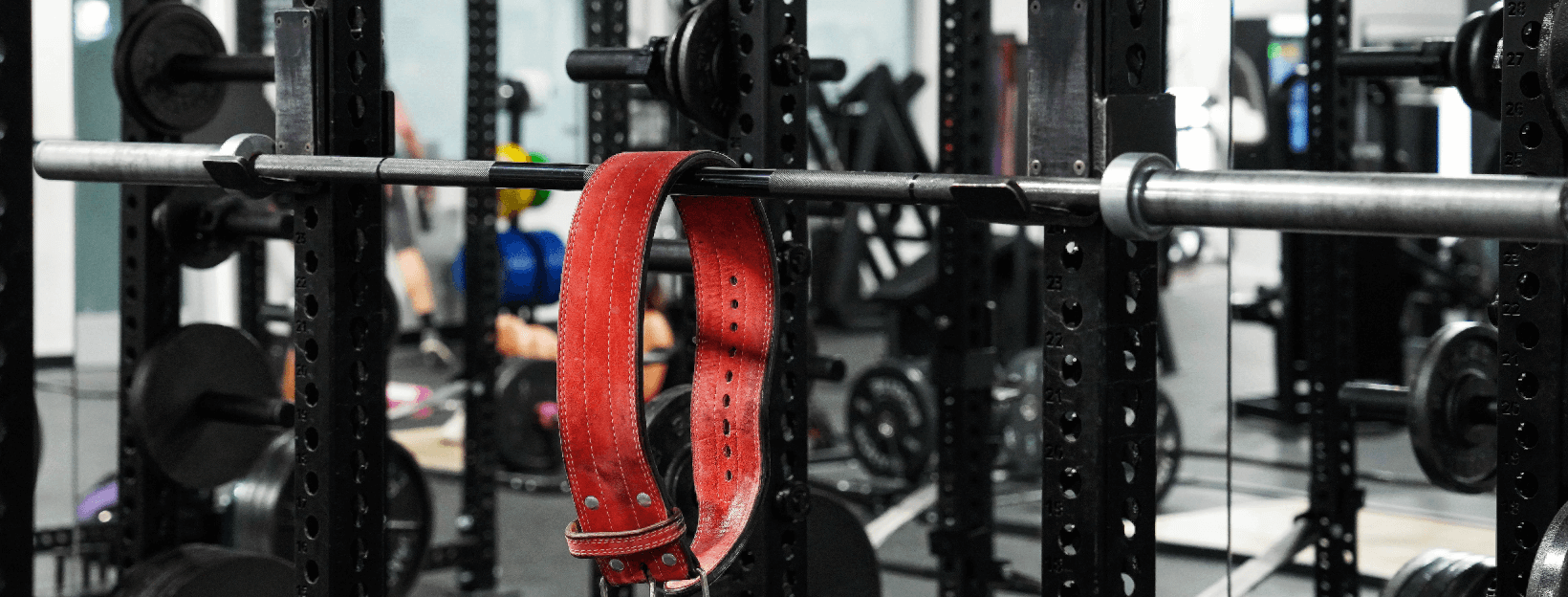The use of lifting belts dates back at least to the 1896 Olympic Games in Athens, Greece. Long before that, it is said that Milo of Croton, the legendary Greek athlete who reportedly lifted a calf every day of his training during the 4-year period between Olympic games, would craft a belt out of the cow’s hide before he competed. Belts remain popular today, with nearly a quarter of gym-goers report using a belt when they lift weights. [1]
Despite the longstanding history and popularity of lifting belts, many questions about them persist. In this article, we’ll explore all things belt-related, including how belts are made, how they work, their effects on performance and injury risk, how to pick the right belt for you, and when to use a belt.
Note: For this article, I pulled every study I could find where they compared wearing a belt to doing the same task without one. This produced a total of 36 studies – 20 from the occupational setting, and 16 where people actually lifted weights. A full accounting of each study is outside the scope of this article, but I’ll review the relevant data for each question we’re answering. Click here to listen to the podcast Dr. Austin Baraki and I recorded on the topic. If you’re in a hurry, check out the executive summary/recap at the bottom of the page.
How Are Weightlifting Belts Made?
Lifting belts are typically made of leather sandwiched between two layers of suede. These layers are glued and stitched together to make the belt. While this is the typical construction of a high-quality lifting belt, there are many variations in materials used in the industry.
Some manufacturers substitute the middle layer of leather with plastic or artificial leather as a way to stiffen the belt. These are typically sold at a lower price than those made with real leather and suede. With regular use, a quality leather and suede belt breaks in over time and becomes more comfortable to use like a baseball glove, whereas belts that use plastic or artificial leather never quite break in, and can be uncomfortable to use.
Lifting belts have three principal dimensions: width, thickness, and length.
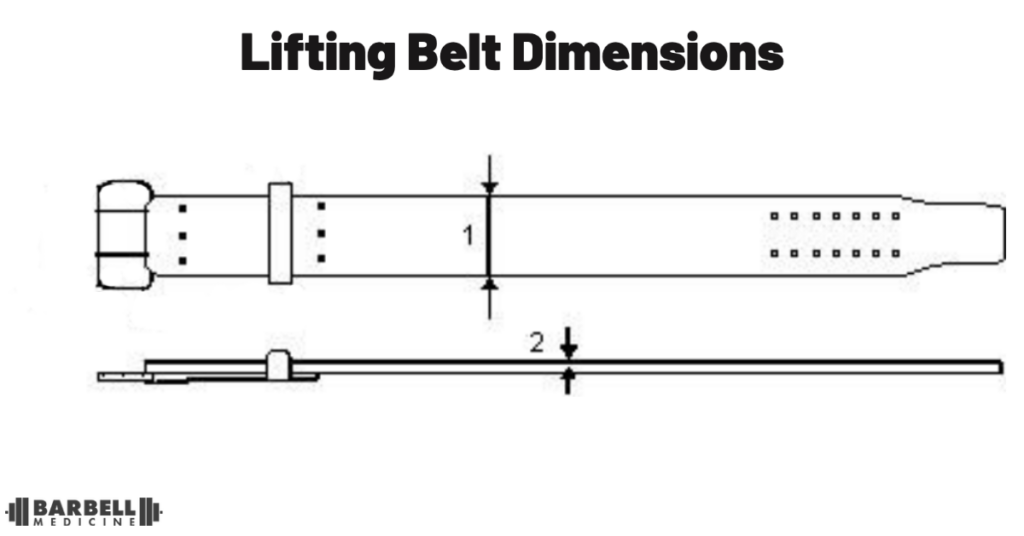
Belt Width (measurement 1) varies depending on the manufacturer and the application. Some belts are the same width all the way around, while others taper – wider in the back and narrower in the front. The most commonly used width in powerlifting is 4 inches or 10 cm, as this is the maximum allowed in sport. [2 There’s more variability in Olympic weightlifting, with some competitors preferring a tapered belt. The maximum width allowed in Olympic weightlifting competition is 4.7 inches or 12 cm. [3] Outside of the rules of competition, there isn’t a standard size, and anything goes as far as belt width is concerned.
Belt thickness (measurement 2) is also variable, with 6.5 mm thick belts being used predominantly in Olympic weightlifting and either 10 or 13 mm thick belts being used in powerlifting. Differences in lifting belt thicknesses alter the way belts are constructed:
- A 6.5 mm belt is one piece of 6.5 mm thick leather
- A 10 mm thick belt is one piece of 6 to 6.5 mm thick leather sandwiched between two 2 mm thick layers of suede, thus totaling 10 mm
- A 13 mm belt has two 4.5 mm thick layers of leather between two 2-mm thick layers of suede, thus totaling 13 mm
*Of note, there are also belts constructed without suede, e.g. all-leather belts, which are made with alligator, crocodile, or similar “leather” material on the outside. They are likely stiffer than leather-suede combo belts.
13 mm is the maximum thickness for a belt to be used in powerlifting competition, but otherwise, anything is fair game. [2]
The proper belt length is a function of the individual’s waist circumference, their body fat, and their desired fit. For example, a person with a 35” waist circumference who is carrying a significant amount of body fat is likely to wear their belt closer to 32”, which is about the same as a lean individual with a 32” waist circumference.
Manufacturers use a die and a press to cut holes in the belt for the fastening mechanism. There are a number of different fastening mechanisms available, e.g. single prong, double prong, and a lever device.
High-quality belts typically have 1 inch between holes center-to-center, to leave enough leather between the holes so that the belt doesn’t tear. Lesser-quality belts tend to have greater spacing between holes, as the materials used are more prone to tearing with the holes too close.
We’ll talk about how to pick the right belt for you later in this article, but that’s the overview of belt construction.
How Do Weightlifting Belts Work?
The most common mechanisms by which belts are said to “work”, that is, allow someone to lift more weight, do more reps, or reduce injury potential, are by increasing intra-abdominal pressure, increasing muscle activity, and/or by doing the job of the muscles as a potential “crutch”. Let’s address each one of these individually.
Intra-abdominal pressure
Intra-abdominal pressure (IAP) is the force exerted by the contents within the abdominal cavity, which is variable based on both the respiratory phase and abdominal wall resistance. [4, 5] In humans, IAP goes up when we breathe in, as the diaphragm contracts and descends, thereby reducing the space within the abdominal cavity. If we take a breath and hold it like we do during a Valsalva maneuver, IAP goes up substantially, as the combination of holding our breath and added muscular tension from the abdominal wall decreases the volume of the intra-abdominal cavity. Conversely, when the diaphragm relaxes and moves upward as we exhale, intra-abdominal pressure goes down due to the increasing volume of the abdominal cavity.
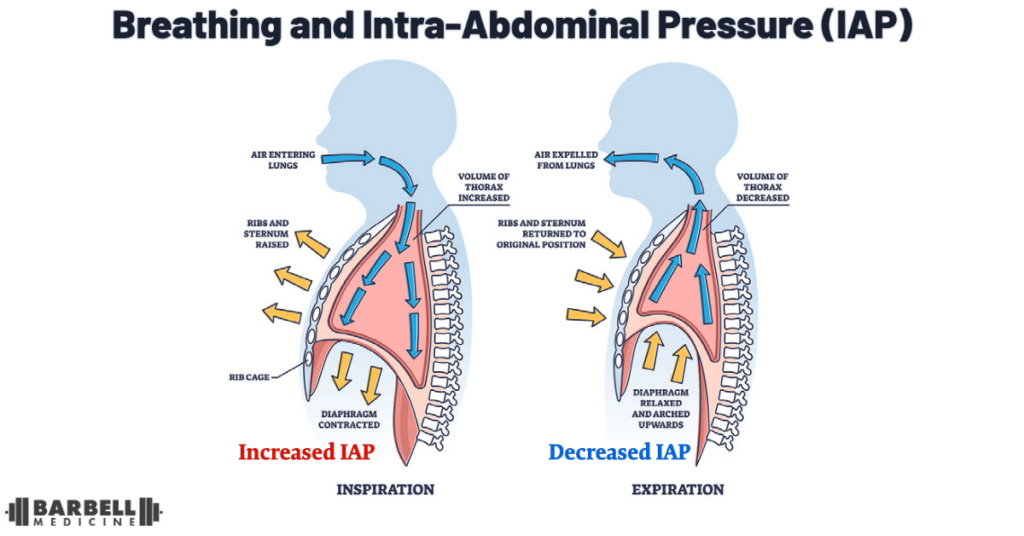
In healthy individuals, the average intra-abdominal pressure while standing upright is about 20 mmHg, and increases to 65 mmHg when performing a Valsalva maneuver. [6] With respect to lifting weights, intra-abdominal pressure appears to be important, as people reflexively hold their breath and increase their intra-abdominal pressure by performing a Valsalva maneuver. [7, 8] Still, these numbers are far lower than what is seen during hard physical efforts like deadlifting 90% of a 1-Rep Maximum. Research shows that subjects had an average intra-abdominal pressure of 156 mmHg without wearing a belt and 175 mmHg with a belt. [9]
These findings suggest that there may be an additive increase in IAP when combining a belt and Valsalva maneuver, but we’ll need to look at more data to get a better sense of what’s going on. To measure IAP, researchers insert a small tube into either the stomach or rectum to measure the force created by the contents of the abdomen during various tasks.
Out of all the data currently available on belts during lifting tasks, seven investigated changes in IAP. Of the seven, five demonstrated a significant increase in IAP with a belt as compared to not wearing a belt and the other two did not find a consistent trend.
In a study conducted on nine young individuals deadlift 90% of their 1RM, which was tested beltless, IAP was measured at 175 mmHg with a belt and 156 mmHg without. IAP also increased at a faster rate before the lifting started with the belt as compared to without. [9] In another study, six adults deadlifted loads ranging between 73 and 91 kg on a machine with and without a belt, and with and without a conscious Valsalva maneuver. IAP was highest with the belt and with the conscious Valsalva maneuver. [10] A similar additive increase was observed in a lifting study where nine young men performed rack pulls and deadlifts at 37.5 and 75% their bodyweight, with and without a belt, and with two different breathing techniques: breathing in first then holding it (e.g. a Valsalva maneuver), or breathing out first and then holding it. IAP was highest with a belt and a Valsalva maneuver. [11] In another lifting study, five young men performed an 8-Rep Maximum (RM) squat with and without a belt. The subjects had an average 8RM squat of 125 kg (275 lbs) and the belt increased IAP 25-40% over the beltless condition. [12] The two studies showing no difference in IAP with and without a belt used isometric tasks, which likely doesn’t tell us much about what a belt does during lifting.
Overall, it seems like both wearing a belt and doing a Valsalva maneuver increase IAP during lifting in an additive manner. While the IAP increases are well-supported, these findings raise the question, why is an increase in IAP advantageous during lifting? [8,13]
One thought is that the increase in IAP may increase the amount of muscular force being generated. However, studies investigating this show that under isometric conditions, that is, where the subjects are asked to produce a maximal amount of force without moving, the total amount of muscular force production is unchanged. [8,14]
Alternatively, it is possible that the increased IAP values seen with a lifting belt and Valsalva maneuver increase stiffness of the trunk, thereby allowing for more efficient force transfer throughout the body by limiting extraneous motion. In order to support this hypothesis, data showing improvements in lifting task performance, e.g. the ability to complete more reps, lift a heavier weight, and/or lift a given weight through a specified range of motion faster are needed. This will be discussed in the performance section of this article, but first, let’s take a look at how belts affect trunk muscle activity.
Trunk Muscle Activity
There are a number of trunk muscles that work in concert to manage movement, position, and rigidity through muscular force production. To create muscular force, electric signals are carried by a nerve to the muscle that is supposed to contract. These electrical signals can be measured by surface electromyography (sEMG), which uses an electrode placed on the muscle’s surface to capture the electrical activity going on below. The electrical activity values measured by sEMG indicate the level of excitation, with higher or lower levels indicating more or less excitation, respectively.
While EMG experiments cannot be used to infer motor unit recruitment, e.g. how much muscle mass is being called upon to contract, or how often the electrical signal is being sent, it can tell us how robust the level of muscle excitation is during a particular task as compared to its maximal value that was determined beforehand.
The theory here is that greater sEMG amplitude implies greater muscle excitation, which implies greater potential strength and hypertrophy responses, though this remains yet to be proven. [15]
While 14 studies sought out to investigate the effects of wearing a lifting belt on trunk muscle excitation, a number of them are from the occupational setting, using tasks that aren’t similar to lifting weights in the gym. After removing those, the studies conducted during gym lifting tasks show that sEMG values of the trunk muscles are relatively low during lifting tasks like squats and deadlifts regardless of whether a belt is used.
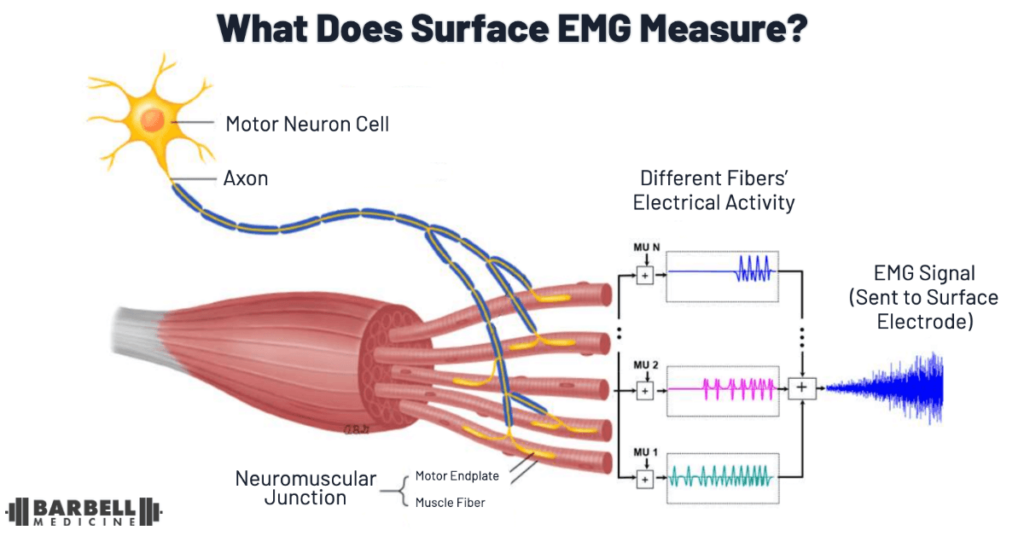
For example, in a study where six adults deadlifted between 73 and 91 kg on a machine, the average sEMG for the trunk muscles investigated “never exceeded 15% of that produced by an isometric maximal voluntary contraction, with or without a belt; nor were there appreciable differences in abdominal sEMGs whether belts were worn or not.” [10]
Another study compared trunk muscular activity during a 12RM sumo and conventional style deadlifts with and without a belt. While there were higher sEMG values in the oblique muscles without a belt, the amount of muscular excitation was a fraction of maximal: 62% of maximal voluntary contraction without the belt compared to 53% of maximal voluntary contraction with a belt. On the other hand, higher sEMG values were found in the rectus abdominis muscle when using a belt (63%) compared to without (56%), though these are still only fractionally different compared to a maximal contraction. [16]
The remainder of the studies measuring sEMG find mixed results, but again, still demonstrating notably submaximal sEMG values. While two studies showed no significant differences in sEMG values while using a belt during back squats – one study where the subjects did 8RM squats with and without a belt and another where subjects squatted 90% of their 1RM, a third study showed an increase in erector spinae excitation with a belt during a 3-repetition set of squats at 60% of 1RM. [12,17,18] Two other studies showed mixed sEMG results. One showed no difference in rectus abdominis sEMG, but lower iliocostalis sEMG values when deadlifting 1.5-times bodyweight. [11] The other found that men had higher sEMG values of the right oblique when using a soft, non-leather lifting belt during a light partial deadlift, while the women in the study had lower sEMG values with the belt. Again, this was a very small percentage of maximal sEMG. [19]
One additional study investigating trunk muscle activity when using a lifting belt did so in a slightly different manner. In this study, Intramuscular pressure (IMP) was measured via a small catheter placed within the erector spinae muscle group. IMP is the fluid pressure within the muscle itself that is directly related to muscle force production. In general, when IMP goes up, so does muscle force production. While the relationship between IMP and muscular force production can vary depending on the orientation of the muscle fibers, in this context, an increase in pressure within the muscle probably correlates to more muscular force production. [20] sEMG was also measured for the erectors, rectus abdominis, and external oblique muscles. During isometric lifting tasks, the researchers found that IMP increased significantly in the erector muscles when using a belt. While the sEMG values were higher for the erector muscles with a belt than without, the difference was not statistically significant.[8]
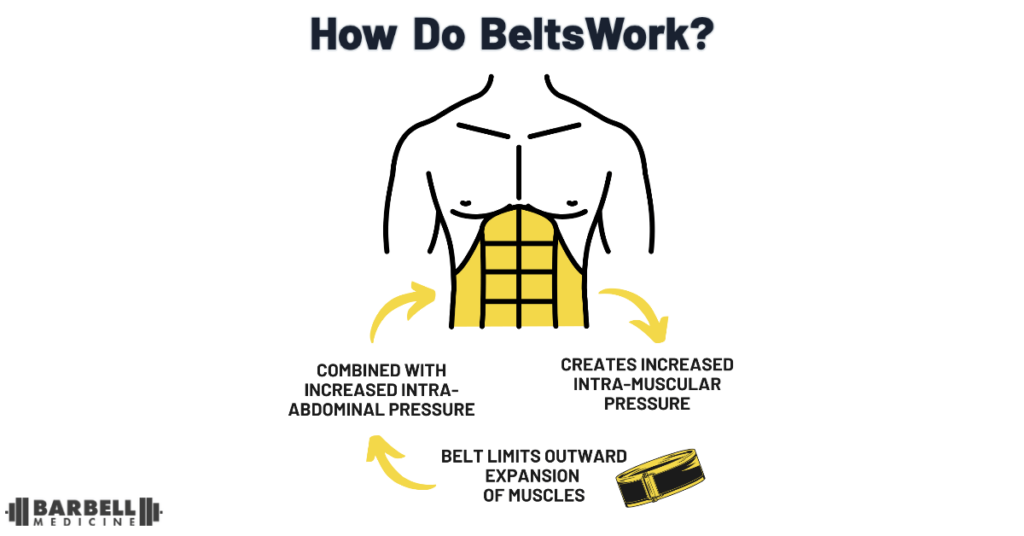
Overall, it looks like trunk muscle activity isn’t much different when using a belt. Practically speaking, this means that a belt is likely not causing the trunk muscles to function at a lower level, or reducing the fitness adaptations incurred from resistance training. In fact, direct tests of trunk strength and endurance in workers using a belt for two and three months showed that on average, strength and endurance improved with regular belt use. [21]
Even if we assume that changes in sEMG or IMP correlate with changes in strength or muscle growth – assumptions that have yet to be proven – these differences are quite small, if present at all. Instead, it seems that if wearing a belt improves performance during lifting tasks, it does so by a mechanism that has little to do with altering muscular force production. Let’s take a closer look at the data here.
Do Weightlifting Belts Help/Improve Performance?
Unfortunately, there are no studies looking directly at whether or not people can lift more weight with a belt. However, there is evidence suggesting that people likely lift more weight with a belt than without.
For example, one study measured the velocity that subjects could squat 90% of their 1RM with and without a belt. While sEMG of the erectors, hamstrings, glutes, and quadriceps muscles was no different with and without a belt, the subjects completed the rep 15.5% faster on the way up when using a belt. There was also a trend towards an increased range of motion, with a slight increase in depth. This suggests an improvement in force transfer from the primary movers, e.g. the legs, through the trunk to where the bar was placed on top of the back, without compromising the range of motion. [17]
These findings were corroborated by another study where subjects completed an 8RM squat with and without a belt. Despite squatting with a balloon catheter inserted ~10-cm into their rectums to measure IAP, the subjects tended to move the final few reps faster when wearing a belt than without. [12]
Wearing a belt also seems to reduce the difficulty of performing a lift. In a recent study, subjects deadlifted 80% of their 1RM for a one repetition with and without a belt. While the time to complete the rep was similar in both conditions, subjects’ rate of perceived exertion (RPE) was an average of two points lower when wearing a belt than going beltless. [22]
Of course, not all of the evidence is perfect here. One study where individuals deadlifted 90% of their 1-Rep Maximum with and without a belt showed no change in velocity or ground reactive forces. [9]
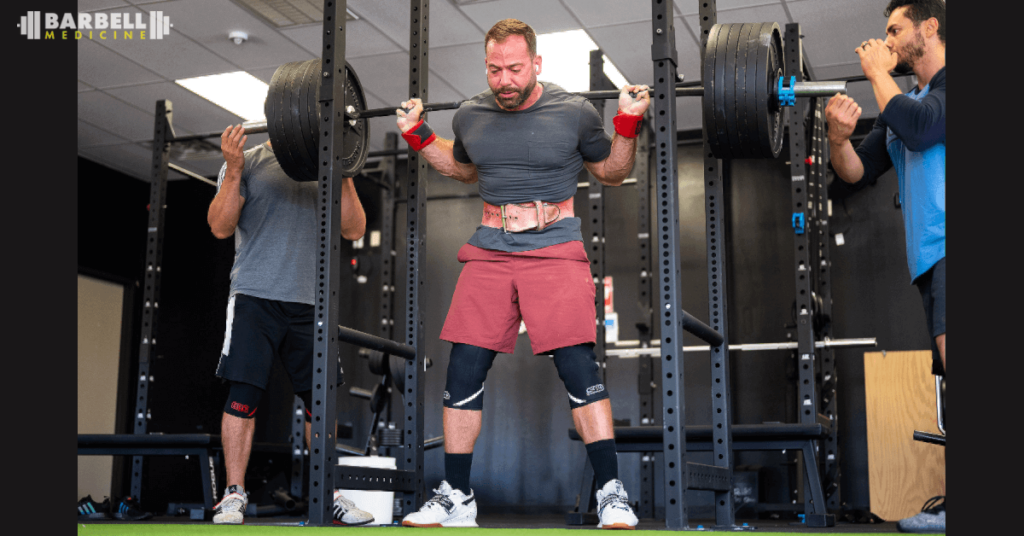
Overall, it seems like wearing a belt tends to improve lifting performance to some degree, likely through increasing the efficiency of force transfer through the trunk plus some placebo-type effect. There is likely significant variability in how much a belt can help based on the movement, the individual, and other factors. More well-controlled data on how lifting belts alter 1-RM or similar efforts in barbell training would be helpful to strengthen confidence in these mechanisms and conclusions. Anecdotally, most – but not all – people do seem to lift more weight in most exercises when wearing a belt. As with most things concerning humans, individual differences are the norm.
Do Belts Reduce Risk of Injury?
One of the most thoroughly investigated outcomes relating to belt use in the workplace is whether or not they reduce the risk of low back injury. Globally, low back pain affected over 600 million adults in 2020 and is the leading cause of years lived with disability. [23] Considering that low back pain in the US is responsible for nearly 265 million workdays lost per year, multiple industries are keen to learn whether belts can help. [24]
Multiple large, long duration studies across multiple different industries have repeatedly found the same thing: belts do not reliably reduce risk of low back injury, lost or restricted work days, or workman’s compensation claims due to low back injury. [25, 26, 27]
For example, one study looked at over 1000 employees working at Tinker Air Force Base in Oklahoma and the difference in back injury incidence, lost or limited duty work days, and treatment of back injury based on whether or not they were wearing a belt. [28] There were no differences between those who wore a belt and those who did not, which led to the National Institute for Occupational Safety and Health (and other organizations) to conclude:
“After a review of the scientific literature, NIOSH has concluded that, because of limitations of the studies that have analyzed workplace use of back belts, the results cannot be used to either support or refute the effectiveness of back belts in injury reduction.” [29]
Low back pain is common, with a lifetime risk of nearly 85% in the general population and 61% in athletes. [30, 31] While nearly 90% of gym-goers who wear a belt claim they do so to “prevent injury”, the data from the occupational science worlds do not support this claim. [1] Further, lifting weights – with or without a belt – is actually one of the safest types of exercise available, with an average injury rate of about 1-4 injuries per 1000 participation hours for all different styles of resistance training. [32,33, 34]
How To Pick the Right Weightlifting Belt
As mentioned at the outset, the belt industry varies wildly with respect to the quality of materials used and dimensions available for purchase. In this section, I’ll discuss the details of picking a high quality belt for lifting weights, though it should be noted that an individual’s preference for sizing, materials, and fit supersedes these recommendations.
Materials
I recommend selecting a belt made from leather and/or suede depending on the desired thickness, as these are the main materials used in constructing a quality lifting belt that will last decades. Nylon belts are also available, but are typically reserved for individuals who prefer a more flexible belt for non-barbell-focused activities such as CrossFit and some strongman events.
Thickness
For general strength training with barbells, I recommend a 10-mm thick belt made of leather between two layers of suede. For competitive powerlifting, I would recommend a 13-mm thick belt, again made of leather and suede. The 13-mm thick belt is notably stiffer, which is generally preferred by most competitors. For competitive Olympic weightlifting, I would recommend a 6.5-mm thick full-leather belt.
Width
For most lifters, a 4” wide belt is the appropriate choice regardless of competitive aspirations. Notable exceptions include competitive Olympic weightlifters, shorter lifters (< 5’5”), or those with a very short torso. Competitive Olympic weightlifters may prefer a belt that tapers from 4” in the back to 2.5” in the front. Shorter individuals and/or those with a very short torso may prefer a 3” wide belt. In general, most individuals don’t require different belts for different lifts, e.g. a 4” belt for squats and a 3” belt for deadlifts, though as always, individual preferences may vary.
Length/Sizing
Belt sizing is not standardized across the industry. Therefore, it is suggested that the individual measures their waist circumference and select a size where the waist measurement falls near the middle of the sizing range for a particular manufacturer. For custom-made belts, the measured waist circumference should be where the center hole is cut on the belt, giving the user plenty of room in case of future weight gain or loss.
An additional variable that should be considered is body fat, as someone who is carrying a significant amount of body fat is likely to wear their belt much at a smaller size than a lean individual with the same waist measurement. In general, purchasing a belt where the waist circumference falls in the middle of a particular manufacturer’s size range takes care of this potential problem. For example, an individual with a 35” waist circumference might purchase a “medium” belt from Pioneer, where the medium belt size spans from 31- to 40-inches.
Closure
The main types of closure devices used for lifting belts are single prong, double prong, lever, and velcro. Velcro belts are reserved for some non-barbell-focused applications like certain strongman events and CrossFit metabolic conditioning workouts. For both general and competitive strength training, one of the other choices are recommended based on an individual’s preferences.
In general, double prong belts are a bit more difficult to close and open than those with a single prong, but do not offer any additional stiffness or durability. Having had both types of belts, I prefer a single prong belt over a double prong due to ease of use. I also feel that the thicker single prong belt may hold up better over time compared to a double prong, although this is speculative.
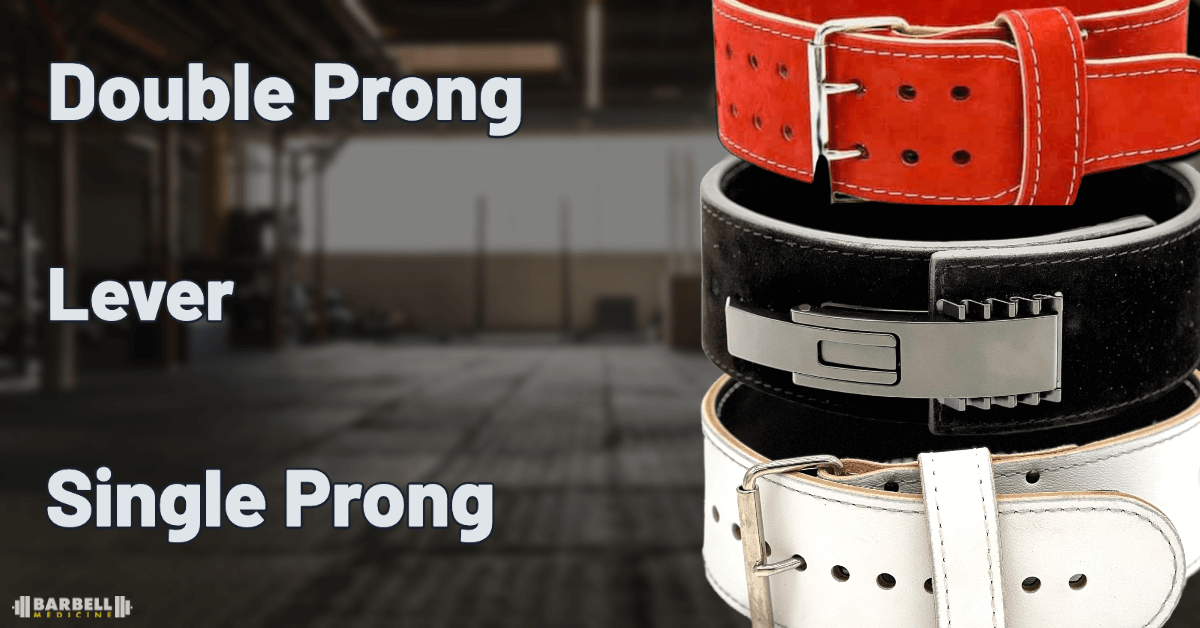
Finally, you may prefer a lever mechanism, as these tend to be the easiest device to close and open. Inzer was the first company to produce a belt using a lever closure decades ago. Lifters can adjust the closed diameter of the belt by using a screwdriver to loosen the latch and move it along the holes that are cut into the belt at 1” spacing intervals. SBD also offers a lever belt with 1” hole spacing, however no tools are required to move the latch. Finally, Pioneer offers a lever belt with “Pioneer Adjustable Lever” (PAL) closure device. The big difference here is that the PAL device allows for ½” adjustments with the latch placed to fine tune the belt’s closed dimension.
Again, the closure is entirely dependent on an individual’s preferences.
Brands
There are many different belt manufacturers making belts at different price points and various levels of quality. That said, a belt is an investment that is likely to last the majority of your training career, so I feel that it’s better to buy “nice” than buy “twice”. For reference, I have been using the same belt for over 10 years at this point with no complaints.
I recommend purchasing a belt from a manufacturer who uses only high quality leather and suede for construction. If the belt hole spacing is greater than 1” or the manufacturer doesn’t make a single prong option, I have concerns over the quality of materials being used.
In saying that, I have no reservations in recommending belts from Pioneer, Inzer, or SBD. Other brands like Best Belts, Titan, and Cardillo make good belts as well, though availability can vary. Full disclosure, Pioneer belts is a sponsor of the Barbell Medicine podcast. If you would like to support those who support us, it would be appreciated, but you can’t go wrong with any of these options.
When To Use a Belt
It is possible to lift weights productively for a very long time without using a lifting belt, though most would be able to lift heavier weights with a belt than without. With that in mind, I recommend using a belt for all “priority” lifts, i.e. the lifts an individual cares the most about improving.
In general, priority lifts are performed earlier in a workout so that performance is maximized within a training session. In strength training, the priority lifts are typically some variation of the squat, bench press, deadlift, and the overhead press. I’d recommend using a belt for the heaviest exposures to these lifts each week. A lifter may consider going beltless the rest of time in an effort to manage the total training stress generated from the program, although this is similarly up to individual preference.
My theory here is that the absolute load being used imparts some amount of fatigue on the individual independent of RPE. Consider the following scenarios:
- Scenario A: Lifter squats 80% of their 1RM for 3 sets of 4 reps @ RPE 8 with a belt, which ends up being 315 pounds.
- Scenario B: Lifter squats 80% of their 1RM for 3 sets of 4 reps @ RPE 8 without a belt, which ends up being 300 pounds.
While the volume (sets x reps), movement, and proximity to failure (RPE) are the same in both scenarios, the absolute weight is higher in the individual using a belt. My prediction is that scenario A imparts more training stress due to the heavier absolute load. Thus, using a belt for more (or all) exercises may increase training stress compared to limiting the use of a belt to only the priority exercises. Higher absolute loads may be favored when preparing for a competition or 1RM strength test, but a more moderate approach may be appropriate for general strength training. Again, this is just a theory, but this is where I typically start when it comes to using a belt.
If we agree that using a belt both feels different and alters the mechanics of a lift via increasing trunk stiffness compared to lifting beltless, then another prudent recommendation would be to use the belt on the last warm-up and working sets at a minimum. This is how I personally do it, but introducing the belt during even earlier warm-ups is another strategy that is perfectly acceptable.
Finally, someone with back pain may benefit from more liberal use of a belt in order to stay active. While the use of a lifting belt doesn’t seem to prevent or treat low back pain, maintaining adequate levels of physical activity during an injury tends to reduce detraining, pain symptoms, and duration. If someone feels more comfortable using a belt to lift, that’s totally fine compared to not using a belt and being less active.
Weightlifting Belts Recap
The following summary will condense nearly 5000 words on lifting belts:
- Use of a lifting belt tends to increase lifting performance without reducing muscular activity of the trunk.
- Lifting belts do not significantly decrease or increase the risk of injury.
- Regular use of lifting belts does not reduce trunk muscle strength or endurance.
- Lifting belts work by increasing the stiffness of the trunk by increasing intra-abdominal and intra-muscular pressures. This allows for more efficient muscular force transfer throughout the body. There may also be some element of a placebo effect when using a belt.
- High quality belts are typically made of leather that, depending on thickness, may be between two layers of suede.
- Many different sizes are available and personal preference supersedes any particular recommendation. Most general strength trainees will prefer a 10 mm thick, 4” wide, single prong belt. For competitive powerlifters, a 13 mm thick belt may be preferred. For Olympic weightlifters, a 6.5 mm thick leather belt is a common choice. It is suggested that the individual measures their waist circumference and selects a size where the waist measurement falls near the middle of the sizing range for a particular manufacturer.
- There are many different belt manufacturers making belts at different price points and various levels of quality. We recommend one from Pioneer, Inzer,or SBD.
- For those trying to maximize performance, lifting belts should be used for the highest priority exercises in their program.
- Use of a lifting belt is not required for strength training.
Thanks for reading. If you enjoyed the piece, feel free to share it on social media!
References
- Finnie, Steven B et al. “Weight lifting belt use patterns among a population of health club members.” Journal of strength and conditioning research vol. 17,3 (2003): 498-502. doi:10.1519/1533-4287
- “Technical Rules – International Powerlifting Federation IPF.” IPF – International Powerlifting Federation, www.powerlifting.sport/rules/codes/info/technical-rules. Accessed 30 May 2023.
- International Weightlifting Federation 20 Technical and Competition 20 …, iwf.sport/wp-content/uploads/downloads/2020/01/IWF_TCRR_2020.pdf. Accessed 31 May 2023.
- Tzelepis, G E et al. “Transmission of pressure within the abdomen.” Journal of applied physiology (Bethesda, Md. : 1985) vol. 81,3 (1996): 1111-4. doi:10.1152/jappl.1996.81.3.1111
- De Keulenaer, B L et al. “What is normal intra-abdominal pressure and how is it affected by positioning, body mass and positive end-expiratory pressure?.” Intensive care medicine vol. 35,6 (2009): 969-76. doi:10.1007/s00134-009-1445-0
- Cobb, William S et al. “Normal intraabdominal pressure in healthy adults.” The Journal of surgical research vol. 129,2 (2005): 231-5. doi:10.1016/j.jss.2005.06.015
- Hemborg, B et al. “Intra-abdominal pressure and trunk muscle activity during lifting. IV. The causal factors of the intra-abdominal pressure rise.” Scandinavian journal of rehabilitation medicine vol. 17,1 (1985): 25-38.
- Miyamoto, K et al. “Effects of abdominal belts on intra-abdominal pressure, intra-muscular pressure in the erector spinae muscles and myoelectrical activities of trunk muscles.” Clinical biomechanics (Bristol, Avon) vol. 14,2 (1999): 79-87. doi:10.1016/s0268-0033(98)00070-9
- Harman, E A et al. “Effects of a belt on intra-abdominal pressure during weight lifting.” Medicine and science in sports and exercise vol. 21,2 (1989): 186-90.
- McGill, S M et al. “The effect of an abdominal belt on trunk muscle activity and intra-abdominal pressure during squat lifts.” Ergonomics vol. 33,2 (1990): 147-60. doi:10.1080/00140139008927106
- Kingma, Idsart et al. “Effect of a stiff lifting belt on spine compression during lifting.” Spine vol. 31,22 (2006): E833-9. doi:10.1097/01.brs.0000240670.50834.77
- Lander, J E et al. “The effectiveness of weight-belts during multiple repetitions of the squat exercise.” Medicine and science in sports and exercise vol. 24,5 (1992): 603-9.
- Nachemson, A et al. “Mechanical effectiveness studies of lumbar spine orthoses.” Scandinavian journal of rehabilitation medicine. Supplement vol. 9 (1983): 139-49.
- Hagins, Marshall et al. “The effects of breath control on maximum force and IAP during a maximum isometric lifting task.” Clinical biomechanics (Bristol, Avon) vol. 21,8 (2006): 775-80. doi:10.1016/j.clinbiomech.2006.04.003
- Vigotsky, Andrew D et al. “Interpreting Signal Amplitudes in Surface Electromyography Studies in Sport and Rehabilitation Sciences.” Frontiers in physiology vol. 8 985. 4 Jan. 2018, doi:10.3389/fphys.2017.00985
- Escamilla, Rafael F et al. “An electromyographic analysis of sumo and conventional style deadlifts.” Medicine and science in sports and exercise vol. 34,4 (2002): 682-8. doi:10.1097/00005768-200204000-00019
- Zink, A J et al. “The effects of a weight belt on trunk and leg muscle activity and joint kinematics during the squat exercise.” Journal of strength and conditioning research vol. 15,2 (2001): 235-40.
- Bauer, Jeffrey A., et al. “The Use of Lumbar-Supporting Weight Belts While Performing Squats: Erector Spinae Electromyographic Activity.” The Journal of Strength and Conditioning Research, vol. 13, no. 4, 1999, p. 384, https://doi.org/10.1519/1533-4287(1999)013<0384:tuolsw>2.0.co;2.
- Warren, L P et al. “Effect of soft lumbar support belt on abdominal oblique muscle activity in nonimpaired adults during squat lifting.” The Journal of orthopaedic and sports physical therapy vol. 31,6 (2001): 316-23. doi:10.2519/jospt.2001.31.6.316
- Ateş, Filiz et al. “Intramuscular Pressure of Tibialis Anterior Reflects Ankle Torque but Does Not Follow Joint Angle-Torque Relationship.” Frontiers in physiology vol. 9 22. 24 Jan. 2018, doi:10.3389/fphys.2018.00022
- Holmström, E, and U Moritz. “Effects of lumbar belts on trunk muscle strength and endurance: a follow-up study of construction workers.” Journal of spinal disorders vol. 5,3 (1992): 260-6. doi:10.1097/00002517-199209000-00003
- Fong, Shirley S M et al. “The influence of weightlifting belts and wrist straps on deadlift kinematics, time to complete a deadlift and rating of perceived exertion in male recreational weightlifters: An observational study.” Medicine vol. 101,7 (2022): e28918. doi:10.1097/MD.0000000000028918
- Ferreira, Manuela et al. (2023). Global, Regional, and National Burden of Low Back Pain, 1990–2020, Its Attributable Risk Factors, And Projections to 2050: A Systematic Analysis of the Global Burden of Disease Study 2021. 10.2139/ssrn.4318392.
- Bone, U. S., and Joint Initiative. “The burden of musculoskeletal diseases in the United States (BMUS).” Rosemont, IL: OrgtoPaedic Research Society (2014).
- Wassell, J T et al. “A prospective study of back belts for prevention of back pain and injury.” JAMA vol. 284,21 (2000): 2727-32. doi:10.1001/jama.284.21.2727
- Martimo, Kari-Pekka et al. “Effect of training and lifting equipment for preventing back pain in lifting and handling: systematic review.” BMJ (Clinical research ed.) vol. 336,7641 (2008): 429-31. doi:10.1136/bmj.39463.418380.BE
- Reddell, C R et al. “An evaluation of a weightlifting belt and back injury prevention training class for airline baggage handlers.” Applied ergonomics vol. 23,5 (1992): 319-29. doi:10.1016/0003-6870(92)90293-5
- Mitchell, L V et al. “Effectiveness and cost-effectiveness of employer-issued back belts in areas of high risk for back injury.” Journal of occupational medicine. : official publication of the Industrial Medical Association vol. 36,1 (1994): 90-4.
- “Back Belts – Do They Prevent Injury? (94-127).” Centers for Disease Control and Prevention, 6 June 2014, www.cdc.gov/niosh/docs/94-127/default.html.
- WHO Scientific Group on the Burden of Musculoskeletal Conditions at the Start of the New Millennium. “The burden of musculoskeletal conditions at the start of the new millennium.” World Health Organization technical report series vol. 919 (2003): i-x, 1-218, back cover.
- Trompeter, Katharina et al. “Prevalence of Back Pain in Sports: A Systematic Review of the Literature.” Sports medicine (Auckland, N.Z.) vol. 47,6 (2017): 1183-1207. doi:10.1007/s40279-016-0645-3
- Aasa, Ulrika et al. “Injuries among weightlifters and powerlifters: a systematic review.” British journal of sports medicine vol. 51,4 (2017): 211-219. doi:10.1136/bjsports-2016-096037
- Keogh, Justin W L, and Paul W Winwood. “The Epidemiology of Injuries Across the Weight-Training Sports.” Sports medicine (Auckland, N.Z.) vol. 47,3 (2017): 479-501. doi:10.1007/s40279-016-0575-0
- Strömbäck, Edit et al. “Prevalence and Consequences of Injuries in Powerlifting: A Cross-sectional Study.” Orthopaedic journal of sports medicine vol. 6,5 2325967118771016. 14 May. 2018, doi:10.1177/2325967118771016
